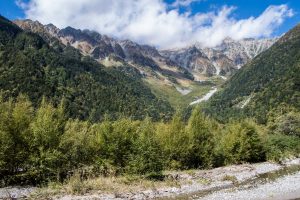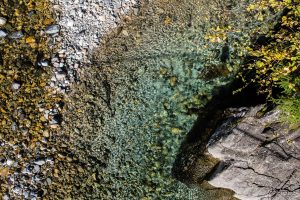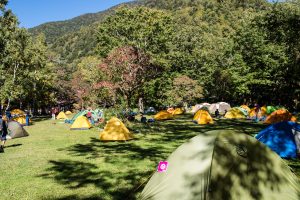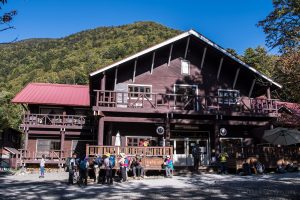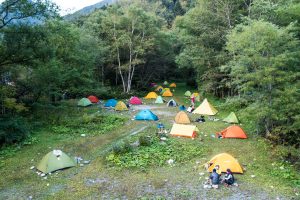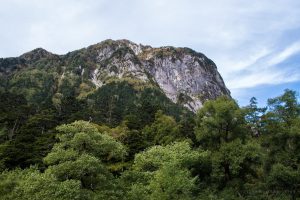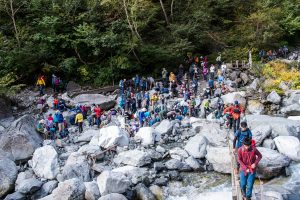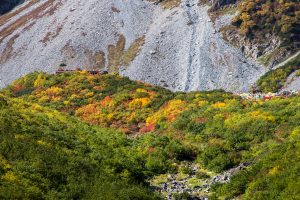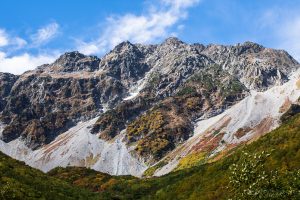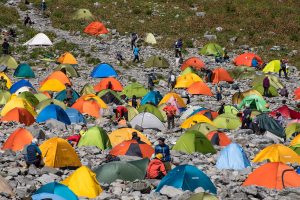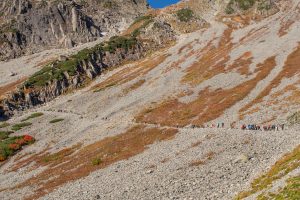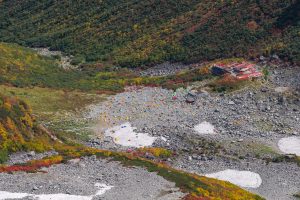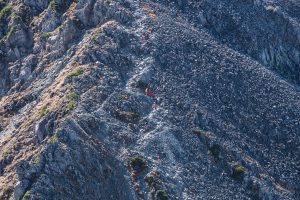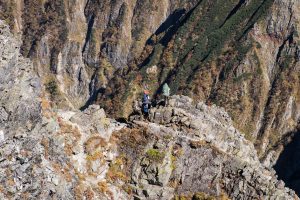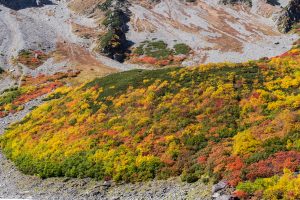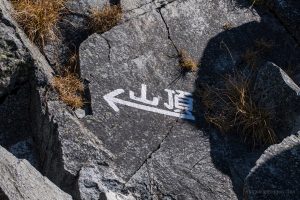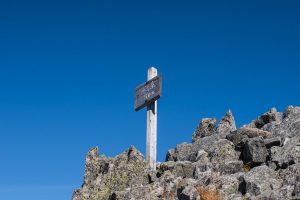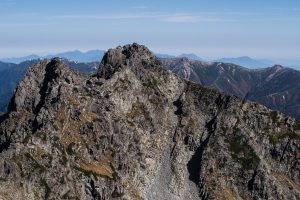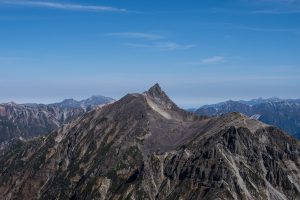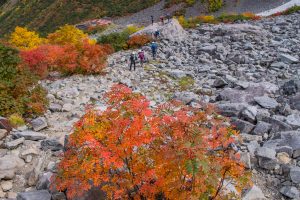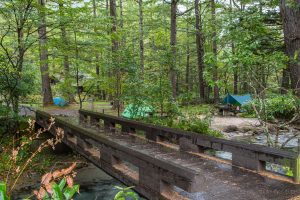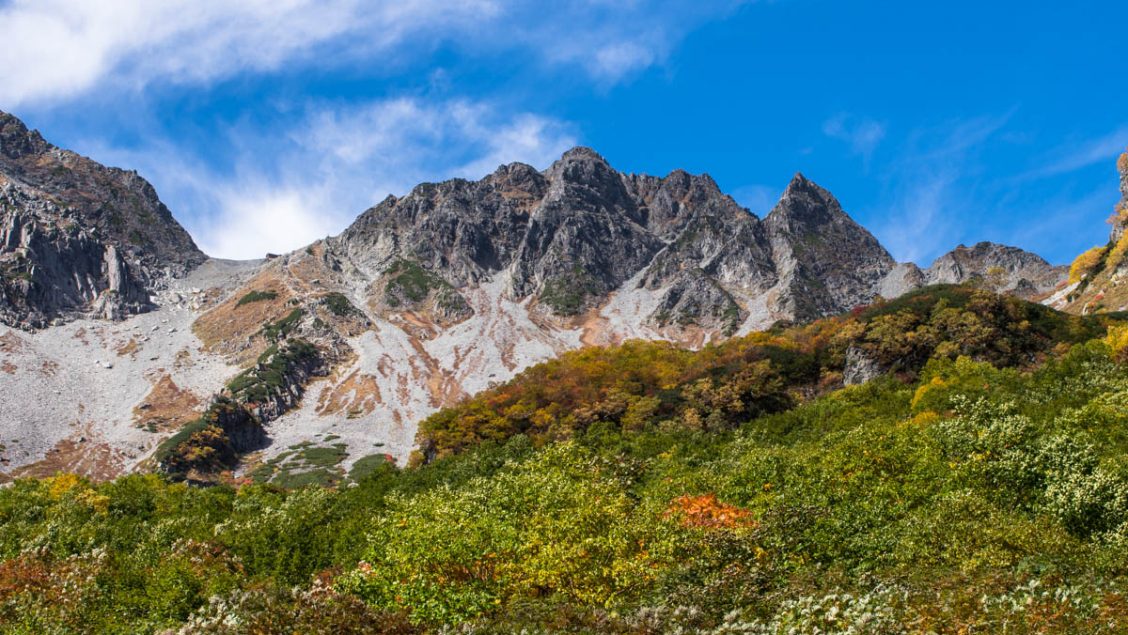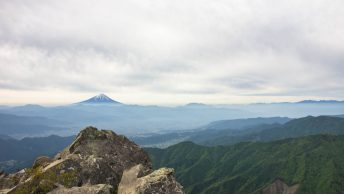.
Kamikochi 上高地 – Karasawa 涸沢 – Mt. Karasawa 涸沢岳
Distance: 36.7 km
Elevation change: 1598 metres
Highest point: 3103 metres
Start: Kamikochi Bus Stop
Finish: Kamikochi Bus Stop
Difficulty: ▅▅▅▅▅▅▅▅▅▅ ❹
Map: Yama to Kogen Chizu 山と高原地図 [No.40 槍ヶ岳・穂高岳 YARIGA-TAKE·HOTAKA-DAKE]
GPX TrackKML TrackGSI MAPPDF Topo Map
Autumn Colours and Incredible Views
There’s a good reason Kamikochi consistently ranks as one of the most popular hiking destinations in Japan – it’s dazzling beautiful especially in the autumn. For this return hike to Mt. Karasawa allow at least three days to do it justice especially at peak times where the crowd numbers will slow your pace. On the upside this should provide you with plenty of time to take in the picture-perfect scenery.
Day 1: Alongside the Banks of the Azusa River (11 km)
Firstly, let’s start with travel logistics. A lot of hiking guides including Lonely Planet Hiking in Japan seem to think most folk will be starting out from Kamikochi in the early morning presumably after a tiring night bus. If you don’t fall into this category and you’re travelling from downtown Tokyo, the earliest you’ll be able to arrive in Kamikochi is around midday – as was the case for this hike. The overnight a highway bus courtesy of the Alpico Group from Shinjuku is however the cheapest way. Alternatively, you can catch a limited express train to Matsumoto, transfer to the Kamikochi Line for Shinshimashima Station 新島々駅 and then take a bus bound for Kamikochi 上高地. A round trip train and bus ticket from Matsumoto to Kamikochi will set you back 4,550 yen.
The downside of arriving at lunch time is that the furthest you’ll most likely get to is the Yokoo-sanso 横尾山荘. From the Kamikochi bus terminal it’s a few hundred metres to the famous Kappabashi (Kappa Bridge) and the nearby Konashidaira Camping Ground (800 yen) which makes an excellent spot to camp at either the beginning or end of the hike. For the first 11 km to Yokoo along the picturesque Kamikochi valley the trail follows a gentle gradient. This stretch attracts large numbers of day trippers as well as hikers and rightfully so as the scenery is gorgeous. If you happen to start the hike in the afternoon the quaint campsite at the Tokusawa Lodge 徳沢ロッヂ is another camping option.
The Yokoo-sanso Camping Ground (700 yen) is spilt into two zones with a larger more secluded area next to the Azusa River. I recommend heading to this area first as the main camping area next to the lodge is often jam-packed in the busy season.
Day 2: Joining the ‘Tent City’ (6 km)
Like the previous day the trail starts off gently as it meanders alongside the watercourse. After passing over the suspension bridge look out for the striking Byobu-iwa 屏風岩 a famed rock climbing wall. One thing to mention is the biggest problem you’ll encounter if you tackle any Kamikochi hike in the peak autumn season are the crowds and leaving early doesn’t seem to make much of a difference. Not only do you have to contend with the hikers ambling slowly in front of you, but you need to factor in delays incurred waiting for those heading back down.
After about 60 minutes from Yokoo you’ll arrive at a river crossing where the real hiking starts. The first section of trail is reasonably steep though not hazardous as indicated on the map. Interestingly, as you gain elevation you can literally pinpoint where the leaves start to change colour. A little further along look out for an open area where you can glimpse the glacial Karasawa cirque 涸沢カール. From here it should only take around 30 minutes to reach the colossal ‘tent city’ that emerges during the autumn. I arrived there around mid-morning which was best as by the mid-afternoon all the official 500 campsites (1,000 yen) had well and truly gone with those still arriving left with very poor offerings such as camping on the snow fields.
Day 3: Great Climbing, Great Views (4.5 km)
After a rather cool night with temperatures dipping below freezing we woke to clear skies. An unexpected sight were the numbers of hikers who had already taken to the trails with their headlamps visible along the upper ridgelines. A huge drawback however of joining the masses at Karasawa are unduly long lines for the toilets. By the time I found myself at the end of the queue a little before 6am it was already absurdly long and took 30 minutes to work my way to the front.
After sorting what gear, I was going to bring along I swiftly made haste for the trail to Mt. Karasawa. On the way up, I choose the more direct path but there is also an alternate route which I took on the way down which commences beside the Karasawa Lodge. After about 30 minutes you’ll find yourself at the beginning of what I dubbed the ‘conga-line’ owing to the endless succession of hikers following lockstep along this straight 500 metre incline. After finishing the conga-line the hiking component is over and is replaced with rock scrambling for the remaining passage to the summit.
Arriving at the Hotaka-hut I was greeted with several hiking groups readying themselves to tackle a warren of ladders up Japan’s third highest peak Mt. Oku-hotaka (3,190 m). My original plan was to follow suit but owing to the crowds and a headache which was starting to make its presence felt I decided instead on the less taxing option of climbing neighbouring Mt. Karasawa (3,103 m). This peak enjoys much of the same scenery as Mt. Oku-hotaka but does so with a lot less fanfare. At the summit of Mt. Karasawa there were only a few of us to savour some of the best views in the Kita Alps. Note the ridgeline between here and Kita-hotaka is steep and exposed and claimed the life of a Korean climber just two days later.
Water can be purchased at the Hotaka-hut for 100 yen a litre and there is also a small unshielded campsite which can apparently squeeze in 25 tents. When you’re ready to head off retrace your steps all the way back to Karasawa heading via the alternate course to view the autumn leaves.
Day 4: Drizzling Conditions on the Hike Back (15.2 km)
By day four the weather had changed for the worst. Thankfully however the rain held off until I arrived back at river crossing. Similar to the second day, half the time battling down to this point could be attributed to trail congestion. By the time I arrived back at Yokoo the rain had settled in and continued to drizzle for the next 24 hours. From here back to Kamikochi took less than two hours. Given the inclement weather I decided to spend an extra night at the Konashidaira Camping Ground which boasts its own sento (600 yen) – a godsend after multiple days out on the trail.
